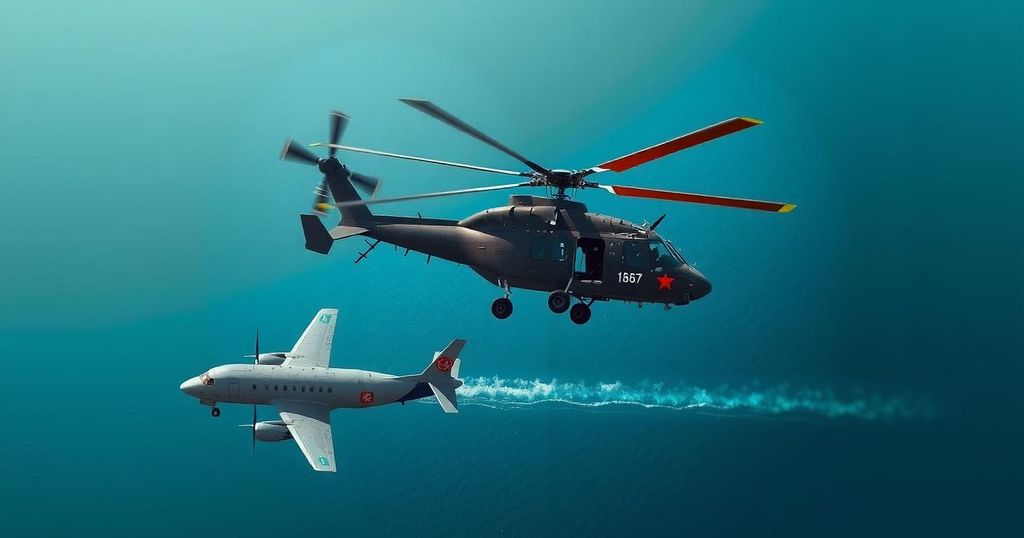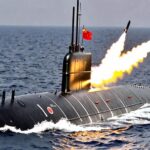Chinese Navy Helicopter Harasses Philippine Patrol Plane Over Panatag Shoal
On Saturday, a Chinese Navy helicopter harassed a Philippine Bureau of Fisheries and Aquatic Resources plane over Panatag Shoal, with the BFAR pilot warning that the helicopter was flying dangerously close. The Chinese helicopter ignored the warnings and continued to approach, reflecting escalating tensions over territorial claims in the South China Sea. The incident follows a disputed maritime background where the Philippines asserts its Exclusive Economic Zone rights against China’s claims.
Tensions between the Philippines and China have escalated in the air over the disputed Panatag Shoal, also known as Bajo de Masinloc, following an incident involving a Chinese military helicopter and a Philippine Bureau of Fisheries and Aquatic Resources (BFAR) aircraft. On Saturday, while on a maritime patrol, the BFAR plane encountered a Harbin Z-9 helicopter from the People’s Liberation Army Navy (PLAN), which approached at an alarming proximity. The BFAR pilot issued a radio warning, describing the Chinese helicopter’s actions as a violation of flight safety protocols, alerting them that their aircraft was within 50 feet of the BFAR plane. The pilot articulated, “Chinese military helicopter, you are violating flight air safety prescribed by the FAA and ICAO. You are flying too close to our position at less than 50 feet. You are endangering the safety of our crew and passengers. We are a Philippine government aircraft performing our mandate to fly and conduct maritime survey over Bajo de Masinloc or Scarborough Shoal within our Exclusive Economic Zone. Be wary of safety and distance your aircraft from our position.” Despite this admonition, the Chinese helicopter proceeded to close the distance to as few as six meters, asserting Beijing’s apparent claim over the navigational airspace in the region. As the BFAR plane prepared to depart, a Chinese warship, the guided missile destroyer Hefei, was detected 25 nautical miles east of the shoal, challenging the BFAR aircraft via radio by stating, “Philippine aircraft, this is Chinese navy warship…” The BFAR pilot responded, reminding them that they were operating outside their 200 nautical mile Exclusive Economic Zone. Additionally, a China Coast Guard vessel was sighted north of Panatag Shoal, accompanied by six Chinese militia vessels in the vicinity. The increase in Chinese military presence is reflective of ongoing tensions in the region, particularly since the Philippines secured a favorable ruling from an international tribunal in 2016 regarding its maritime rights, which China has yet to acknowledge.
The incident waters down a long-standing maritime dispute between the Philippines and China over the South China Sea, especially Panatag Shoal. The Philippines, by international law, claims the area as part of its Exclusive Economic Zone (EEZ), allowing it rights over the resources in the vicinity. China, however, asserts a historical claim over the entire South China Sea, leading to regular confrontations and heightened military activity in the region. The situation complicated further since an international ruling in The Hague in 2016, which supported the Philippines’ claims and denounced the legal basis of China’s assertions in the South China Sea. Despite this, China has largely ignored the tribunal’s ruling, resulting in continued tensions and periodic encounters like the recent episode involving BFAR.
The recent confrontation between the BFAR and a Chinese military helicopter underscores ongoing friction in the South China Sea, reflecting both nations’ competing claims over the disputed waters. This incident not only highlights the risks involved in aerial encounters but also reinforces the Philippines’ stance on its territorial rights within its Exclusive Economic Zone, recognized under international maritime law. As regional tensions rise, it is evident that aerial and naval confrontations will remain a critical aspect of Sino-Philippine relations moving forward.
Original Source: www.gmanetwork.com








Post Comment